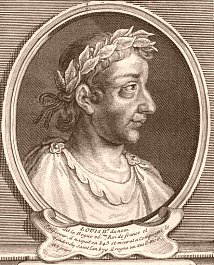The eldest son of King Lothair and his wife Emma of Italy, daughter of Lothair II of Italy, Louis was born c.?966–67. His father associated him to the government in 978 and had him officially crowned as co-king on 8 June 979 at the Abbey of Saint-Corneille in Compiègne by Archbishop Adalbero of Reims; and he assumed full power after Lothair's death in 986. Louis V was the last Carolingian King of West Francia and reigned in Laon from 2 March, 986 until his death, at the age of 20, in 21 May, 987.
In 982 at Vieille-Brioude, Haute-Loire, the fifteen year old Louis was married to the forty year old Adelaide-Blanche of Anjou, sister of Count Geoffrey I and twice a widow from her previous marriage with Count Stephen of Gévaudan and Count Raymond of Toulouse, Prince of Gothia. This union was purely political and arranged by the king – following the advices of Queen Emma and Count Geoffrey I – with the double purpose of restoring the Carolingian royal power in the south of the kingdom, and (according to Richerus) to obtain the support of the local southern lords in his fight against the Robertians: being now related by marriage with two of the most powerful southern comital families of the Kingdom, Lothair believed that he could confront the power of Hugh Capet.
Immediately after their wedding, Louis and Adelaide-Blanche were crowned King and Queen of Aquitaine by Adelaide's brother Bishop Guy of le Puy. However, since the very beginning the mismatched couple was unable to peacefully live together, not only due to the notorious age difference between them but (according to Richerus) also because of Louis' debauched lifestyle:
Reign and death. On his father's death on 2 March 986, the already crowned Louis V became the undisputed King of the Franks.
 |
| King Louis V |
However, at that time in the Frankish court existed two parties: one led by Archbishop Adalberon of Reims and Queen Emma, who, being strongly influenced by her mother Empress Adelaide, wanted the renewal of friendly relationships with the Ottonian dynasty; the other party, on the other hand, wanted to continue Lothair's policy, and, taking advantage of the minority of Emperor Otto III, wanted a policy of expansion to the east and the recovery of Lotharingia. In addition, the young monarch inherited a battle between his father's line of elected kings (which had been interrupted twice by the Robertian kings and once by the Bosonid family), and the Ottonian house of the Holy Roman Emperor Otto I.
As defender of Rome, Otto I had the power to name the clergy in Carolingian territory, and the clergy he had named were not supporting the Carolingians. Initially Queen Emma dominated the situation, but in the summer of 986, there was a reversal: The Anti-Ottonian party prevailed, and she was forced to leave court and seek refuge with Hugh Capet. This event also put Adalberon in a predicament: being elevated by Otto I to the powerful archbishopric of Reims, he was forced to leave his episcopal seat and took refuge in one of his fortresses on the Meuse river, who belonged to the Ottonian sphere.
The escape of he Archbishop was perceived by Louis V as treason; he turned violently against Adalberon and threatened him to besiege Reims, with the matter being finally settled in a trial court at Compiègne. However, before this meeting Louis V changed his mind and sought a reconciliation with Adalberon; in the spring of 987 he also planned a peace meeting with Empress Theophanu, who could act on behalf of her son Otto III. Before all these tangled events were resolved, Louis V died on 21 May 987 from a fall while hunting in the Forest of Halatte near the town of Senlis, Oise. He was buried in the Abbey of Saint-Corneille in Compiègne.
He left no legitimate heirs, so his uncle Charles, Duke of Lower Lorraine, was nominated as the hereditary successor to the throne. But the clergy, including both Adalberon and Gerbert (who later became Pope Sylvester II), argued eloquently for election Hugh Capet, who was not only of royal blood but had proven himself through his actions and his military might. Capet was elected to the Frankish throne and Adalberon crowned him, all within two months of Louis V's death. Thus the rule of the Carolingian dynasty ended and the Capetian era began.











